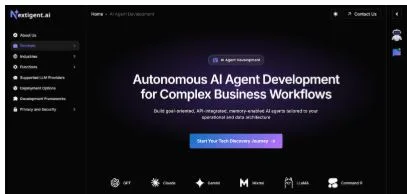Building AI Agents that Deliver Real Business ROI
Over the past decade, enterprises have automated thousands of workflows — from invoice approvals to marketing analytics. Yet, most automation tools remain reactive, not intelligent. The new generation of AI agents changes that paradigm.
Unlike chatbots or robotic process automation (RPA), AI agents are goal-driven systems that can plan, decide, and act autonomously within digital ecosystems. They represent the next step in enterprise transformation — from rule-based efficiency to cognitive collaboration.
What Makes an AI Agent Different
A true AI agent is not a single algorithm but a fusion of reasoning, memory, and action. It can:
- Understand intent expressed in natural language;
- Break down goals into actionable steps;
- Interact with other systems through APIs;
- Learn and optimise through feedback;
- Comply with organisational rules and ethics.
In short, AI agents don’t just automate — they orchestrate.
The Architecture Behind AI Agents
Developing such systems requires an ecosystem rather than a single model. Typical AI agent architecture includes:
- Cognitive Layer – a large language model (LLM) or reasoning engine responsible for planning and decision-making.
- Memory Layer – stores historical interactions, user context, and prior outcomes.
- Action Layer – connects to tools, APIs, CRMs, or internal databases.
- Monitoring Layer – tracks performance, ensures compliance, and logs reasoning for transparency.
This layered design allows agents to evolve without breaking enterprise security or data policies.
Where AI Agents Create Immediate Value
1. Customer Operations
Customer-facing AI agents can resolve complex requests, escalate only when needed, and maintain a unified record across channels. This reduces average handling time by up to 35% while improving satisfaction.
2. Finance and Compliance
AI agents monitor transactions, generate audit summaries, and identify outliers. Their ability to analyse unstructured documents accelerates compliance reviews from days to hours.
3. Software and IT Support
Internal service agents troubleshoot code errors, recommend fixes, and auto-generate documentation — freeing up engineers for innovation.
4. Human Resources
Recruitment and onboarding agents pre-screen candidates, answer policy questions, and coordinate schedules, acting as digital HR assistants.
Designing an AI Agent Strategy
Before building, organisations should assess readiness in five key dimensions:
- Process maturity: Is the task stable and measurable?
- Data quality: Are records accurate and accessible?
- Governance: Are there clear permission layers and audit trails?
- Human interaction: How much supervision or approval is required?
- Integration: Can the agent connect with existing enterprise systems?
Selecting the right pilot use case — a process with high volume and low risk — helps build internal confidence and demonstrate measurable ROI.
Best Practices for Development
- Start with narrow intelligence.
Focus on a single, well-defined goal. Broad ambitions often fail due to lack of focus and data specificity. - Prioritise explainability.
Log every reasoning step. Human oversight builds trust and aids compliance with frameworks such as GDPR, SOC 2, or HIPAA. - Use reinforcement and feedback loops.
Allow the agent to learn from successful outcomes and human corrections. - Secure by design.
Implement access control, prompt sanitisation, and encryption from day one. - Continuously iterate.
Agents evolve with changing data and tasks — maintenance is a strategic investment, not an afterthought.
Measuring ROI in the Age of Intelligent Agents
While automation ROI was once calculated by time saved, AI agents require multi-dimensional metrics:
- Decision accuracy: How well the agent meets intended outcomes.
- Operational efficiency: Reduction in manual interventions.
- User satisfaction: Internal and external feedback loops.
- Compliance adherence: Audit readiness and error reduction.
- Knowledge retention: Improvement in institutional memory through AI-driven documentation.
When aligned with business KPIs, these metrics reveal how AI agents can convert intelligence into tangible value.
Ethical and Regulatory Frontiers
With autonomy comes responsibility. Enterprises must address:
- Transparency: Agents should explain their logic in human-readable form.
- Bias mitigation: Continuous testing across demographic and contextual variations.
- Accountability: Establish clear escalation when the system’s confidence drops below threshold.
- Data protection: Adherence to privacy regulations in every operational region.
Responsible AI governance is not a constraint — it’s a foundation for sustainable adoption.
The Road Ahead: Multi-Agent Collaboration
The future will not be about one super-agent but about networks of specialised agents working in sync. A marketing agent will feed insights to a pricing agent, which coordinates with a supply-chain agent — all under a central governance hub.
This distributed intelligence mirrors human teamwork, only faster, more scalable, and less error-prone.
Conclusion
AI agent development is no longer experimental; it’s becoming a core pillar of enterprise automation. Organisations that invest early in well-governed, explainable, and scalable AI agents will unlock not just efficiency but strategic foresight.
In a world shifting from automation to autonomy, the question is no longer “What can AI do?” but “What should your AI agent decide next?”






